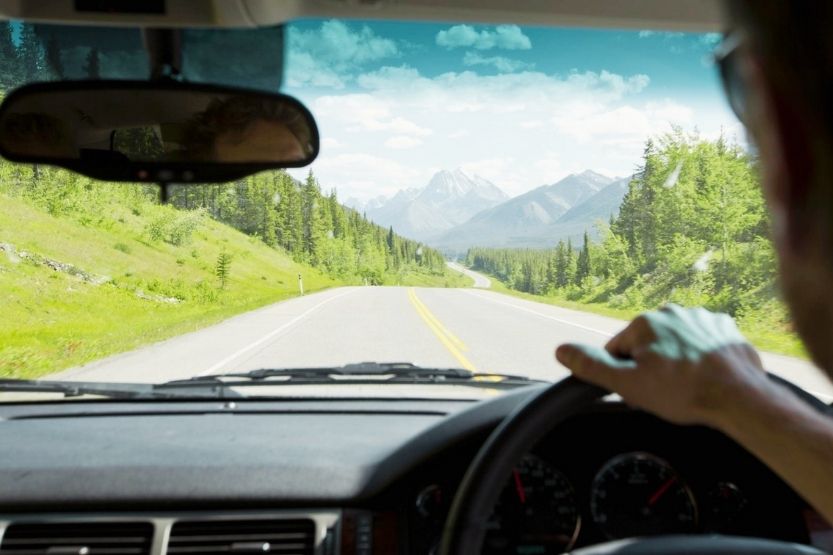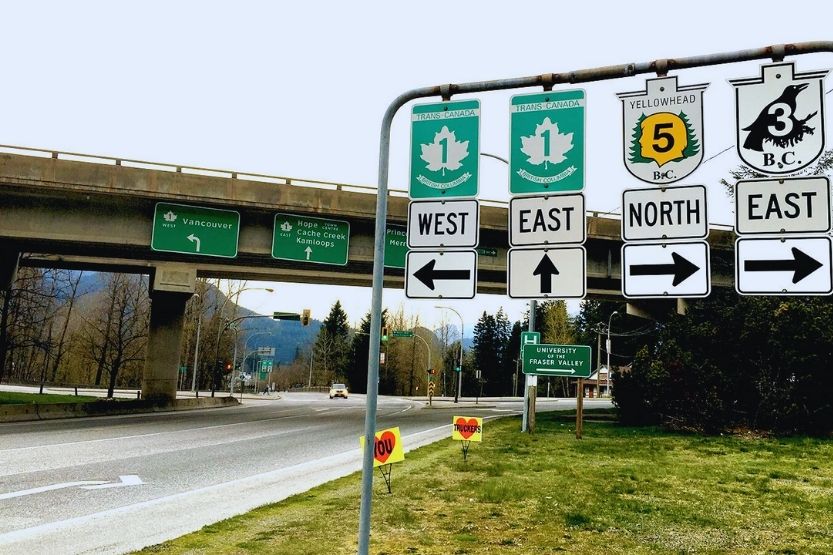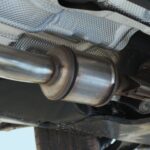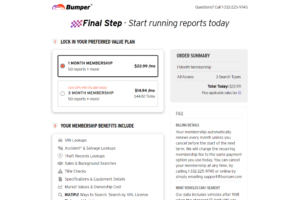Are you planning to visit Canada by driving your car or renting one? Driving in Canada is similar to driving in the United States. However, there are several minor differences in the laws between the two countries. The first question to answer is whether you need a Canadian license. Is it legal to drive in Canada with a U.S. driver’s license?
You can drive in Canada with a U.S. license. A driver’s license from the United States is valid in Canada with proof of car insurance (between 60 to 90 days). You must also be familiar with the driving laws in Canada, among other things.
Read on to learn more about the basic road guidelines in Canada before you cross the border of the U.S.
Can You Drive in Canada With a U.S. License?

Legal to Drive in Canada for Up to 180 Days
Driving in Canada with a U.S. license is legal for up to 180 days. A driver’s license from the United States is valid in Canada with proof of car insurance. You must also be familiar with the driving laws in Canada, among other things.
Pack Up Travel Documents
Before driving to Canada, you must ensure that your travel documents are in order. First off, you need a passport to enter Canada. A visa is not necessary if you are a U.S. citizen.
You can stay in Canada for up to 180 days. To migrate, you must communicate with the proper authorities and require legal counsel.
Requires Driver’s License and Proof of Car Insurance
You need a driver’s license and proof of car insurance to rent a car and drive in Canada. An International Driving Permit (IDP) or a driver’s license in Canada is not required if you are visiting from the U.S.
However, visitors from other countries will need to obtain an IDP and get insurance in Canada. The IDP is essential when traveling from a country where the official language is not French or English.
Age Limit
There is also an age limit, as you must be at least 16 years old to drive. But since the U.S. does not give a driver’s license until age 16, this should not be an issue.
Can I Renew My Existing Driver’s License in Another State?
How Long Can You Drive in Canada with U.S. License?

You can only use your U.S. license for a certain period, which varies by province and territory. You will have a maximum of 90 days to drive before obtaining a Canadian driver’s license. In Ontario, for example, the maximum is 60 days, while in British Columbia, the maximum is 90 days.
Driving in Canada with a Rented Car from the U.S.
No Additional Fees for Using Rental Automobile When Crossing the Border to Canada
Most rental companies will allow you to cross the border to Canada with your rental automobile and will not charge you any additional fees.
Prepare Supplementary Insurance Documents
Notifying them in advance if you intend to do so is essential, as they will need to record your itinerary. They will also provide you with supplementary insurance documents legal in Canada.
You may not be allowed to enter Canada without this; if you do, you will be driving illegally because you will be uninsured.
Age Limit
Remember that most rental firms have an age limit, with a minimum age of 21 and a maximum age of 25. As a result, if you’re under 25, you won’t be able to rent a car and drive to Canada.
Renting Is Easier and Less Expensive
Even if you intend to spend significant time in Canada, a one-way rental that begins and ends in the United States will be considerably easier to book and far less expensive than returning the car to Canada.
It’s important to note that if you drive your car into Canada, you’ll have to drive it back across the border to the United States.
While driving your car into the country is a pretty simple process if you’re visiting, it’s lengthy and complicated if you plan on importing the vehicle permanently.
This implies that even if you’re traveling a great distance, you should plan to return your car to the United States to stay on the legal side of the law.
Driving in the Winter in Canada
When driving in Canada, one thing to keep in mind is safety during the winter season. Several sections of Canada experience harsh winters, which you may not be used to as a U.S. resident. So, if you’re driving in Canada during the winter, be prepared to take extra precautions.
Driving in the Canadian winter can be difficult due to heavy snow, whiteout, snowstorms, and black ice, to name a few circumstances.
Driving in Canada with U.S. License During a Pandemic
Download the ArriveCAN App
Travelers from the U.S. should download the ArriveCAN app. The government created this app to let travelers connect with border authorities. With this app, you can do the following:
- Submit passport information
- Proof of Covid-19 vaccination
- Covid test results
- Quarantine plans
- Travel details
Once you enter the information, the ArriveCAN app generates a receipt with a Q.R. code. Present this Q.R. code when you reach the Canadian border.
You can download the ArriveCAN app or create an account online. You must submit all documents in English or French; otherwise, you should provide a certified translation.
General Driving Rules and Guidelines in Canada

To prevent issues or driving to the border just to be turned away, you should keep a few things in mind before driving into Canada.
Below we have listed the specific rules and guidelines that you should be aware of:
1. Road Signs
Road signs in Canada and the United States are fairly similar, but they do not follow the standards outlined in the Manual on Uniform Traffic Control Devices (MUTCD) in the United States. Canadian traffic signs have distinct characteristics, such as:
- Shapes
- Colors
- Typefaces
- Arrows
In Canada, French is spoken in Quebec. Signs in either or both of these languages may be found in Quebec.
Remember that the road regulations in Canada differ from those in the United States, so familiarize yourself with the differences in speed limits and vocabulary before you travel.
There are several significant distinctions, such as the inability to turn right at red traffic lights and that road signage in Quebec will be in French.
2. Speed Limit
Canada’s speed limits are expressed in kilometers rather than miles per hour. Most highways have a speed limit of 100 km/h, while city limits are 50 km/h.
Authorities in Canada use radars, speed traps, and speed cameras to conduct frequent speed checks to ensure that motorists adhere to posted speed limits.
3. Seatbelt
In Canada, everyone in the car must wear a seatbelt, regardless of age. Car seats are required for children under nine or shorter than 145 cm.
4. Smoking
Although smoking is not prohibited in cars, most provinces deem it illegal to smoke in a vehicle with a kid. The rule covers the following:
- Ontario,
- Manitoba,
- New Brunswick,
- Newfoundland and Labrador,
- Saskatchewan,
- Yukon Territory,
- Prince Edward Island, and
- British Columbia.
5. Alcohol
Penalties for Driving Under the Influence of Alcohol
Driving under the influence of alcohol is a severe offense in Canada. Penalties for doing so include the following:
- Arrest,
- Car impoundment, and
- License suspension.
Blood Alcohol Threshold
As a guest, this could jeopardize your ability to return to the country or possibly shorten your recent stay. The blood alcohol threshold is strict in this country. Driving with a blood alcohol content of more than 0.08% is illegal.
Even if you’re driving with a lower blood alcohol percentage, territorial and provincial traffic laws may still apply. Hence, it’s best to avoid driving after drinking.
6. Use of Mobile Phone
You can use your hands-free phone while driving in Canada. Still, it is well-known that multi-tasking while driving is never a good idea. So, unless you’re picking up or making a call, there’s no reason to use your phone while driving.
7. Carpool or High Occupancy Vehicle Lanes
Some provinces offer carpool or HOV lanes to help alleviate traffic, particularly in urban areas. This lane is only for vehicles with at least two occupants. Some signs designate these lanes, and using them is illegal unless you have a company.
8. Toll Road
Toll roads do not play a big part in Canadian roadways; drivers pay tolls on bridges crossing into the USA, including Nova Scotia. 407 Electronic Toll Road (ETR) in Ontario relieves traffic congestion on main arteries connecting Toronto and surrounding communities, particularly Hamilton.
You do not have to stop at a toll booth. The ETR now has an automatic system that captures your license plate as you merge into the 407. You will receive a bill for the mileage traveled on the 407 later, or it will be applied to your car rental payment.
9. Driver’s License
Some states in the United States give driver’s licenses to people who are somewhat younger than the legal driving age in Canada. Take note that the legal driving age in Canada is 16 for learners. You must be 17 or 18 years old to get a full license.
This varies per province, so double-check before traveling. If you are below 16 and have secured a U.S. license, you cannot drive in Canada.
10. Car Insurance
Fines for Driving Without a Car Insurance
Provinces and territories in Canada require car insurance. Driving without car insurance is prohibited in Canada.
You could face serious consequences, including fines from $5,000-$25,000 for a first conviction, $10,000 – $50,000 for a second conviction, and suspension of your driver’s license. Your car may also be seized or impounded for up to three months.
Again, can you drive in Canada with a U.S. license? An International Driving Permit (IDP) is not needed when you plan to drive in Canada. Instead, you can use your U.S. driver’s license. However, note that you should have an IDP if you plan to go to countries where English is not one of the official languages.
In Closing
Whether driving your car or renting one, you can use your U.S. driver’s license in Canada. Car insurance is a requirement, too. Before entering Canada, you must ensure that you have appropriate travel documents. You will need to have a passport to drive into Canada.
Due to the pandemic, there are measures that the Canadian border requires. Travelers from the U.S. should present a receipt with a Q.R. code from the ArriveCAN app at the Canadian border. This app contains passport information, proof of COVID-19 vaccine, and COVID test results.
When driving in Canada, you must follow some restrictions that are unique to the country to avoid getting into problems.
If you’re going on a trip to Canada during the winter, make sure you’re prepared. It’s also possible that the road you’re on has an obstruction. For example, if you’re traveling to remote or mountainous areas, you should ensure your car has the best traction tires available.









